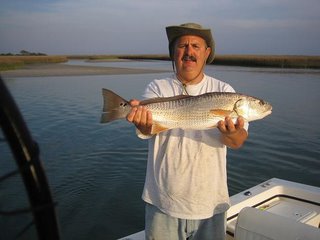Weekly column - July 24, 2006
Flounder are one of my favorite inshore fish -- they are fun to catch and they taste great! However, catching them with any consistency takes practice and patience.
This column is the first of a two-part series containing some of my favorite tips for catching flounder. There are probably as many thoughts on how to fish for flounder as there are fishermen, but I’ll be sharing some of my best techniques learned and practiced over the many years I’ve been flounder fishing.
Let’s start with their habitat. Flounders are predators and their favorite tactic is the ambush. They have a great camouflage in their flat body and spotted topside -- even their eyes are hard to detect. The shade of their skin can change depending on the environment. They lie on the bottom and wait for a potential meal to get close and then attack. They usually do not chase a meal very far, preferring to wait for their prey to come to them.
This mean you will need to put bait "on top" of them. Both pattern casting and drift fishing work well. You want your bait to be on or close to the bottom.
If casting: after you cast and tighten your line, let it set on the bottom for a five count then just pick up the rod tip and let it drop back down. Wait another five count, then retrieve a few feet of line and pick up the rod tip again, repeating this until time to cast again. Another technique is the slow retrieve -- just use a steady but slow retrieve with an occasional pause. With either of these techniques, don’t be surprised to get a "pick-up" on the downward or slack movement of the bait.
Drift fishing for flounder is similar to casting, but you just leave the line out. Be sure to hold the rod -- the flounder usually will not run with bait, so if you set the rod down you may not know if a flounder gets on until too late. A flounder will often turn a live fish in its mouth before completely swallowing it, so patience is required or you risk pulling the bait from its mouth. If you are using live bait, when you feel him pick up your bait, let out a little bit of line to keep him from sensing the weight of the sinker. Then after a 20 count, gently tighten the line and set the hook.
Flounder are likely to spread out over a wide area, so don’t anchor in one spot for hours on end. When the tide is falling, try drifting around the mouths of inlets, rivers and the edges of a channel rather than anchoring. On rising tide, work the pilings around piers, docks and other hard structures.
Often you’ll find them on the flats, when there is enough water, or up against the oyster rocks (little fish hang out there so flounder hide nearby waiting for a meal). Flounder like structures such as sloughs, channels, deep holes, ledges and man-made things like piers and bridges.
When the water turns colder, look for them to move into deeper water and up on the mud bottoms instead of the sand (mud holds heat longer). Where small creeks and tidal ditches connect to bigger channels and creeks can also be productive places.
Remember, think ambush... Where would be a good underwater spot for an ambush? That’s where you’ll find the flounder. More on flounder fishing next week.
Catching report
Inshore and offshore fishing has been hot lately. Drum, trout, flounder and sheephead are being caught in the waterway, creeks and marshes. Look for the drum near the marsh banks or on the nearby flats. Flounder and sheephead are being caught near docks and pier pilings. Spanish and blues are biting near the inlets and along the tide line just off the beaches.
Red drum, a few pompano and some croakers are being caught in the surf. The piers are reporting some nice flounder being caught. They also are seeing some big sheephead taken early in the morning and late afternoon on sand fleas near the pilings. Small blues and mullet round out the catching.
The Kings have moved closer to shore and some smokers have been caught around the near shore reefs and ledges. Mahi are being taken from 10 miles and out -- look for a good weed line to work. Some nice sailfish, marlins and wahoo are being caught out near the Gulf stream.
Tight lines to all!


2 Comments:
I just found your blog and enjoyed reading it. I have it bookmarked. I have done quite a lot of offshore, mostly King fishing. I just bought a flats boat. A Master Angler 21 with a poling platform. I want to get serious about inshore fishing. I would really love to see pictures of your rigs that you fish with. I fish out of Southport, NC.
Steve - thank-you for your kind comments, I'm glad you enjoyed reading my blog. I love to fish both inshore and offshore. I end up fishing inshore alot as I have a small boat and "pick my days" to offshore fish based on the seas.
That's a fine boat you have bought and I'm sure you will catch a lot of fish from it. I mainly use a couple very simple rigs for inshore fishing, variations of a carolina rig, a leadhead for soft plastics and a special dual hook rig for sheepshead. I also occassionally use a modified fish finder rig for drum (like the Owen Lupton Drum Rig). I'll try to post some pictures on my blog.
Tight lines!
Post a Comment
<< Home